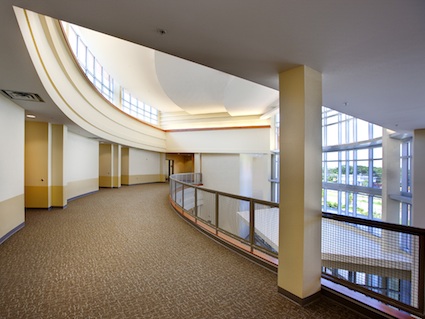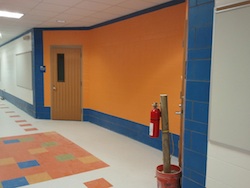Smart Building Spaces Redefine Traditional School Environments

DALLAS — When one thinks of a traditional 19th or 20th century school, one might picture a rectangular articulated masonry structure filled with classrooms and desks. “In today’s 21st century, those of us who design and build learning institutions aspire to enhance not only learning, but to also fulfill the on-the-go, multitasking, electronically connected needs of students, faculty and staff within education systems,” says Darren L. James, AIA, President and COO of KAI, a Texas-based design and build firm with offices in Dallas, Fort Worth and San Antonio. James says that small, pre-planned nooks and welcoming seating areas provide convenient spaces for studying, collaboration, interaction and relaxation. “I refer to these multi-purpose niches as ‘serendipity spaces,’” he says, “and our firm’s design team has successfully incorporated such spaces within a variety elementary, secondary schools and collegiate buildings.”
Amenities that Benefit Everyone
Serendipity spaces manifest themselves in a variety of forms — from quiet study alcoves in a library, to a main traffic lounge complete with computer terminals and a nearby café; or a comfortable niche seating area adjacent to a window with a scenic view. These areas often reduce the sterility of classroom-oriented settings by featuring useful amenities such as private workstations, power outlets, wi-fi, convenient access to refreshments, televisions and reading material. Typically, these incorporate comfortable seating, such as couches and loungers with appropriately sized work tables. Such serendipity spaces are truly essential to allow the most efficient use of space and to offer reasons for students and faculty to interact outside the classroom walls.
A case in point is the Eastfield College Satellite Center, a facility for the Dallas County Community College District (DCCCD) in Dallas, Texas. DCCCD requested a campus that married distinctive design with high functionality. One of the college administrators’ primary goals was to get people inside and make them feel comfortable and welcome in what was to become the first satellite campus in that area of Southeast Dallas. Serendipity spaces were an obvious inclusion to encourage an inviting and approachable atmosphere.
“Forward-thinking building and design professionals should consider incorporating unique, situation-based settings within their building planning to accommodate the needs of educators and students,” James adds. Ideally, these serendipity spaces are distributed throughout the building offering different settings to satisfy a variety of purposeful unplanned conversations or time to get away from mass activity. Such spaces can be separated from other common areas to help reduce background distractions and enhance privacy, or can be in close proximity to main traffic thoroughfares to allow users increased interaction with passersby.
Purposeful Design Stimulates Interaction
 James describes serendipity spaces as purposefully designed alcoves that stimulate interpersonal interactions outside the classroom. Greater collaboration and unrestrained understanding can take place in areas that encourage impromptu conversations between colleagues, a teacher and student, a coach and a player, or between students. “In our firm’s research, we have found that students and teachers appreciate easy access to spaces that foster uninhibited opportunities to chat or brainstorm,” he adds. “It is here, in these spaces, that open discussion and collaboration within educational environments augment the lessons delivered by teaching professionals.” These unstructured environments greatly enhance the learning experience for all parties.
James describes serendipity spaces as purposefully designed alcoves that stimulate interpersonal interactions outside the classroom. Greater collaboration and unrestrained understanding can take place in areas that encourage impromptu conversations between colleagues, a teacher and student, a coach and a player, or between students. “In our firm’s research, we have found that students and teachers appreciate easy access to spaces that foster uninhibited opportunities to chat or brainstorm,” he adds. “It is here, in these spaces, that open discussion and collaboration within educational environments augment the lessons delivered by teaching professionals.” These unstructured environments greatly enhance the learning experience for all parties.
Students and educators alike often request spaces that can accommodate extracurricular activities, class meetings, group projects, and study sessions. For instance, high school and college students often meet outside of class to work on group assignments. With the advent of some form of project-based teaching pedagogy, group dynamics become a skill translatable to the professional world after school. Skills learned from working in small or large groups expand students’ knowledge and confidence.
Serendipity spaces can accommodate a variety of impromptu happenstances as well as student projects requiring extensive movement or additional space to spread out materials. College-based organizations can utilize these spaces to promote activities, host functions and pass out literature. Students in secondary school settings can utilize these flexible areas for fundraisers and awareness campaigns.
Multi-Purpose Spaces for Multi-Tasking People
Educators and students alike are multi-taskers — they appreciate spaces that can be used to concentrate on a myriad of alternatives, whether homework, work planning, family matters, research or even a game of Angry Birds. Serendipity spaces not only provide convenience but also act as an economical solution for students who commute or work outside of school. Commuter students often remain on campus for extended periods of time for economic reasons, or because they commute with other students who have different class schedules. The option to relax and work in pre-planned, individualized spaces improves the quality of their educational experiences.
Serendipity spaces can be inviting places for breaks, as well as provide convenient alternatives to day-to-day dilemmas. For instance, college computer labs often run out of stations, thus requiring students to literally stand in line until a station is vacated. “Well-planned personal spaces allow students to bring their laptops and access the Internet in versatile seating areas and alcoves defined purposefully to fulfill such needs,” James says.
